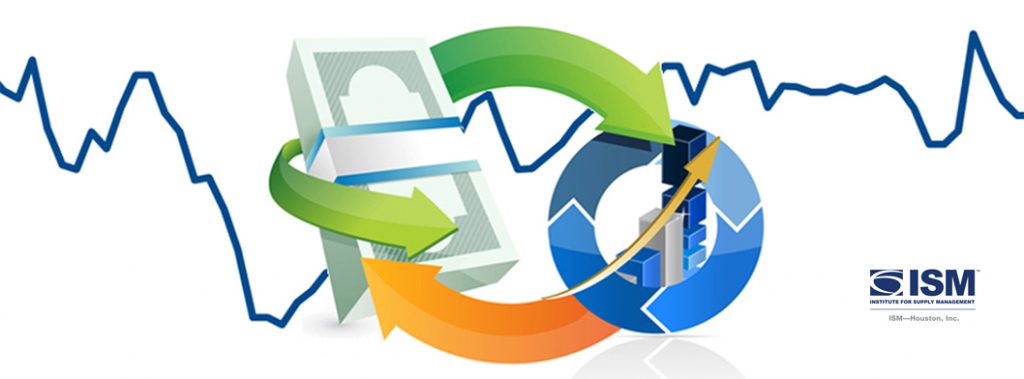
Houston PMI at 53.7 (up 2.4 points from September)
Sales/New Orders Expanding
Production Expanding
Employment Expanding
Prices Paid Expanding
Lead Times Expanding
Finished Goods Inventories Expanding
(Houston, Texas) – According to Houston area supply chain executives, economic activity in Houston continued to expand for the month of October. The manufacturing sector saw a contraction, while nonmanufacturing expanded for the fifth straight month. The overall economy expanded for the 65th month in a row.
The Houston Purchasing Managers Index expanded at a faster rate at 53.7 points, up 2.4 points from September. The lead time, employment and sales/new order indexes, the three indicators with a strong positive correlation with the economy, all indicated expansion (the second time in the last six months). The employment index rose to 50.3 points, up 1.8 points from the previous month, pointing to rising employment. The lead time and sales index each expanded for the fifth month in a row. Lead time rose 1.3 points to 52.6 points, while sales/new orders was up 5.2 points month over month at 60.8. The finished goods inventory index, the underlying indicator that has the strongest inverse correlation with economic activity, rose 1.6 points to 51.9 points, indicating expansion for the fifth month in a row.
The Houston manufacturing PMI index rose 1.3 points during the month to 49.4 points. The nonmanufacturing PMI increased 2.7 points to 54.6 points.
On an industry specific basis: health care, professional services, construction reported strong expansion. Retail trade was the only sector indicating significant contraction.
Please click here for the hard copy report.
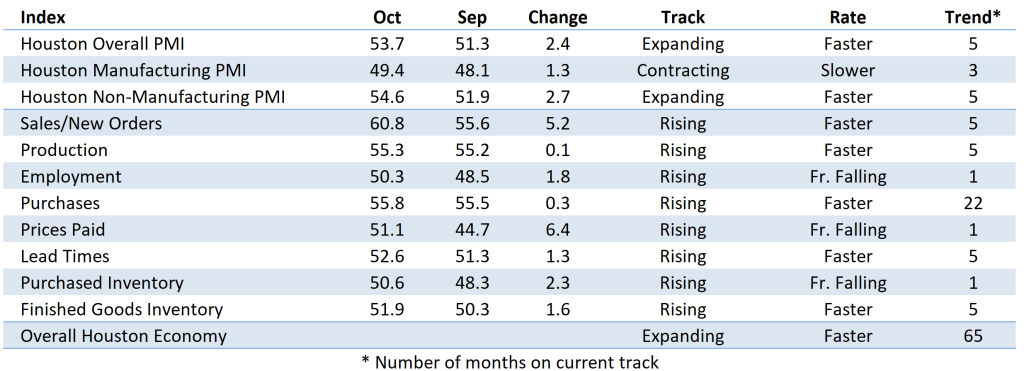
Indices at a Glance
Houston PMI Trend
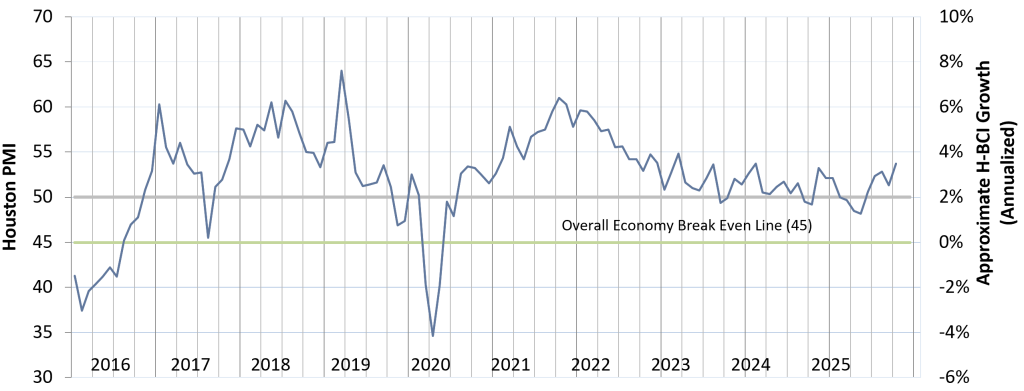
Houston PMI readings over 50 generally indicate that respondents see their activities as expanding. An HPMI above 45 normally correlates with expansion of the Houston-The Woodlands-Sugar Land Business Cycle Index (H-BCI).
Commodities Reported to have Notable Price Changes or to be in Short Supply
Up in Price: Oil field chemicals, imported finished goods and raw materials, film; domestic melt stainless steel, steel, rebar, copper, aluminum, tungsten; electrical gear, electrical equipment, electrical commodities; software, computer hardware; trucking
Down in Price: Olefins cracker feedstocks and other petrochemical raw materials, resins, inconel; warehouse storage, trucking freight, ocean freight
In Short Supply: Nitric acid; tungsten, diamonds, permanent magnets for servo motors, domestic melt wire rod, domestic stainless; electrical gear, transformers; tape; trucking
‡ reported as up or down by different respondents
What our Respondents are Saying
Oil and Gas Exploration, and Key Support Services:
- Lowering expectations for 2026
- Rare earth mineral restrictions in China and increased tariffs continue to be of concern.
- This sector is currently experiencing moderate expansion. Both the sales and production indexes indicate strong expansion; however, the employment and inventory indexes are currently contracting. The purchasing index shows slight expansion, while the prices index indicates moderate expansion. The lead time index is slightly above neutral.
Construction:
- The demand for electric equipment still outpaces supply. However, lead times have decreased slightly.
- The sector is experiencing significant expansion across most indexes. Both the sales and employment indexes indicate strong expansion. Production, purchasing, and prices also show solid growth. Lead times and production inventories show slight expansion, while finished goods inventories and expected employment levels are currently neutral.
Durable Goods Manufacturing:
- Our company experienced an increase in new sales orders compared to the previous month; overall incoming sales for the year are comparable to last year; the lack of new oil & gas drilling activity is the primary reason for lack of year-over-year growth.
- The increase in tariffs has impacted on our commodity costs.
- The sector saw the sales index indicate slight expansion, but both production and employment indexes are currently contracting. Conversely, the purchasing, prices, and lead time indexes all show strong expansion, suggesting pressure on the supply chain. Both production inventories and finished goods inventories are also in contraction.
Non-durable Goods Manufacturing:
- Our feedstock goods warehousing footprint restructuring activity, which was driven by recent tariff increases, is now finished; even with adjustments to minimize tariff impacts, logistics costs are rising, and we are seeing a resulting increase in operating costs and the cost of goods sold.
- Seeing regional issues for trucking, particularly in the “rust belt” region.
- The sector is showing mixed signals this month. The sales index and employment index are both in contraction; however, indexes for production, purchasing, lead time and finished goods inventories are all currently in a state of expansion. The prices index is neutral.
Wholesale and Retail Trade:
- Sales are holding up but we are imposing general price increases due to the need to pass on tariff increases.
- The sales, production, employment, purchasing, lead time, and production inventory indexes are all currently in a state of slight expansion. The price index indicates strong contraction.
Health Care:
- The Health Care sector is experiencing strong expansion across nearly all indexes. Sales, production, employment, purchasing, and lead times all reflect significant growth this month. Prices and finished goods inventories are currently neutral.
Professional and Business Services:
- There has not been any significant change for staffing needs during the month.
- We do not see a shortage of expertise in the market, except for unique technical related and specialized positions.
- Overall, there is no shortage of supply of qualified professionals to fill open positions, whether direct or project hire.
- We are seeing a very slight uptick in prices paid for professional services and general staffing.
- We don’t see any significant increases in what companies are willing to pay if and when they hire.
- We have not witnessed any additional significant wholesale reductions in staff but continue to see “spot” reductions; companies seem to have stabilized their staff levels to work under the premise that $60/bbl oil equivalent prices will be with us for the foreseeable future.
- This sector is exhibiting strong expansion this month, with many indicators significantly above neutral thresholds. The employment, sales, production, purchasing, lead times, and purchased inventory indexes are all in a state of expansion. The prices and finished goods inventories are currently neutral.
Trend of Underlying Indicators
The Houston PMI is based on diffusion indices for eight underlying indicators. The net value of each indicator is simply the percentage of respondents who cite a positive shift from the previous month minus the percentage who cite a negative shift. The diffusion index is calculated based on the percent of respondents reporting higher results plus one-half of those responding the same with seasonal adjustments to the Sales/New Orders, Production, Employment, and Prices Paid indices based on an X13 ARIMA forecast. Values above 50 for Sales/New Orders, Production, Employment, Prices Paid, and Lead Times generally point towards expansion and values below 50 signal contraction. Note that the Prices Paid Index may not follow this trend late in an economic expansion. The Inventory measures have an inverse correlation at most forecast horizons, meaning that values below 50 point to expansion and values above point to contraction. The Purchases index is inversely correlated with economic activity at the three-month forecast horizon.
Sales/New Orders (Seasonally Adjusted)
The overall sales index increased significantly month over month, showing a faster rate of expansion in the nonmanufacturing sector and a sharp decrease in the manufacturing sector.
| Higher | Same | Lower | Net | Index | |
| May/25 | 15% | 75% | 10% | 5% | 49.6 |
| Jun/25 | 20% | 67% | 13% | 7% | 53.6 |
| Jul/25 | 20% | 75% | 5% | 15% | 58.6 |
| Aug/25 | 14% | 82% | 4% | 10% | 55.6 |
| Sep/25 | 11% | 86% | 3% | 8% | 55.6 |
| Oct/25 | 16% | 79% | 5% | 11% | 60.8 |
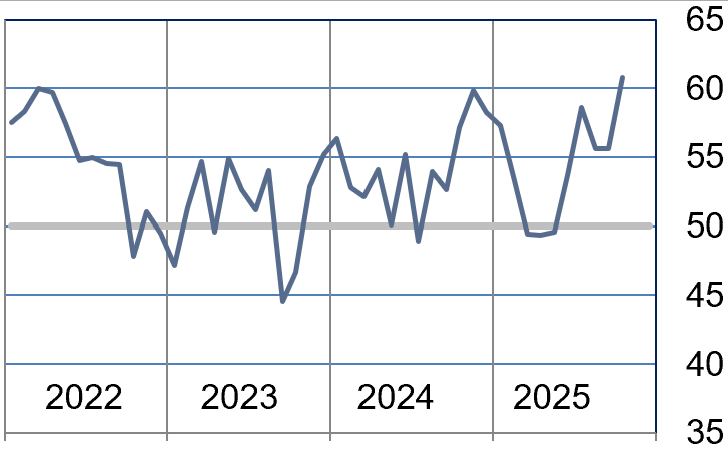
Production Index (Seasonally Adjusted)
The production index increased slightly month over month, with a slightly faster rate of expansion in the nonmanufacturing sector and a continued rate of expansion in the manufacturing sector.
| Higher | Same | Lower | Net | Index | |
| May/25 | 6% | 88% | 6% | 0% | 48.9 |
| Jun/25 | 14% | 78% | 8% | 6% | 53.6 |
| Jul/25 | 12% | 86% | 2% | 10% | 54.2 |
| Aug/25 | 10% | 87% | 3% | 7% | 52.9 |
| Sep/25 | 12% | 84% | 4% | 8% | 55.2 |
| Oct/25 | 11% | 85% | 4% | 7% | 55.3 |
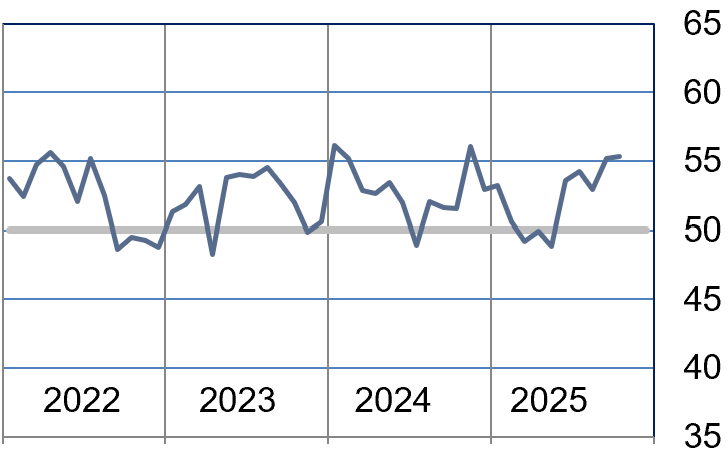
Employment Index (Seasonally Adjusted)
The overall index shifted from contraction to slight expansion. The manufacturing sector remained in contraction despite seeing a sharp increase in its index value, while the nonmanufacturing sector continued its slight expansion.
| Higher | Same | Lower | Net | Index | |
| May/25 | 9% | 75% | 16% | -7% | 45.6 |
| Jun/25 | 8% | 83% | 9% | -1% | 48.6 |
| Jul/25 | 6% | 84% | 10% | -4% | 48.3% |
| Aug/25 | 9% | 82% | 9% | 0% | 51.2 |
| Sep/25 | 11% | 72% | 17% | -6% | 48.5 |
| Oct/25 | 8% | 83% | 9% | -1% | 50.3 |
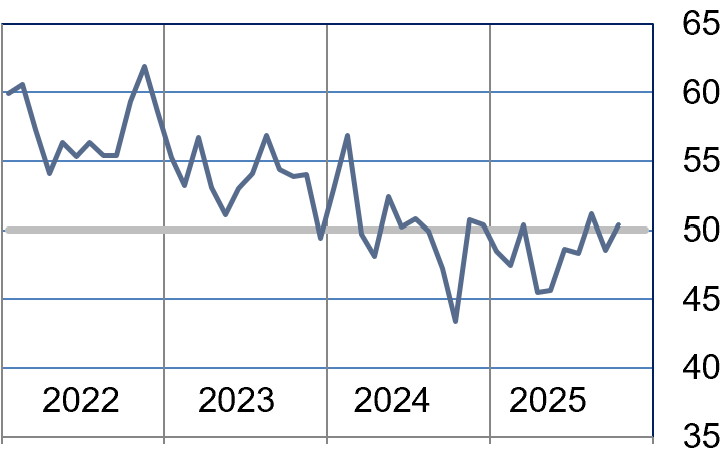
Purchases Index (Not Seasonally Adjusted)
The manufacturing sector shifted from contraction to expansion, while the nonmanufacturing sector remained in expansion and saw a slight increase in its rate of expansion.
| Higher | Same | Lower | Net | Index | |
| May/25 | 16% | 76% | 8% | 8% | 52.3 |
| Jun/25 | 14% | 75% | 11% | 3% | 51.9 |
| Jul/25 | 13% | 82% | 5% | 8% | 54.1% |
| Aug/25 | 7% | 87% | 6% | 1% | 50.8 |
| Sep/25 | 16% | 76% | 8% | 8% | 55.5 |
| Oct/25 | 15% | 78% | 7% | 8% | 55.8 |
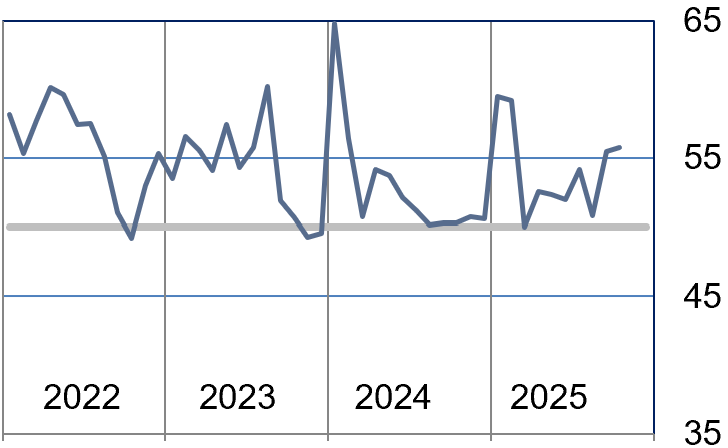
Prices Paid Index (Seasonally Adjusted)
The manufacturing sector remained in expansion despite seeing a decrease. The nonmanufacturing sector shifted from contraction to slight expansion with a sharp increase in its rate of expansion.
| Higher | Same | Lower | Net | Index | |
| May/25 | 17% | 80% | 3% | 14% | 56.1 |
| Jun/25 | 18% | 78% | 4% | 14% | 57.9 |
| Jul/25 | 17% | 80% | 3% | 14% | 57.6 |
| Aug/25 | 12% | 77% | 11% | 1% | 50.1 |
| Sep/25 | 9% | 74% | 17% | -8% | 44.7 |
| Oct/25 | 12% | 78% | 10% | 2% | 51.1 |

Lead Times Index (Not Seasonally Adjusted)
The manufacturing sector remained in strong expansion and saw a sharp increase from September. The nonmanufacturing sector shifted from contraction to slight expansion.
| Higher | Same | Lower | Net | Index | |
| May/25 | 4% | 93% | 3% | 1% | 49.5 |
| Jun/25 | 6% | 91% | 3% | 3% | 51.7 |
| Jul/25 | 10% | 88% | 2% | 8% | 53.5% |
| Aug/25 | 8% | 90% | 2% | 6% | 53.6% |
| Sep/25 | 7% | 90% | 3% | 4% | 51.3 |
| Oct/25 | 8% | 87% | 5% | 3% | 52.6 |

Purchased Inventory Index (Not Seasonally Adjusted)
The manufacturing sector remained in contraction but at a slower rate. The nonmanufacturing sector shifted from contraction to slight expansion.
| Higher | Same | Lower | Net | Index | |
| May/25 | 2% | 94% | 4% | -2% | 47.7 |
| Jun/25 | 6% | 89% | 5% | 1% | 50.0 |
| Jul/25 | 6% | 91% | 3% | 3% | 52.4% |
| Aug/25 | 7% | 89% | 4% | 3% | 50.9 |
| Sep/25 | 6% | 85% | 9% | -3% | 48.3 |
| Oct/25 | 6% | 87% | 7% | -1% | 50.6 |
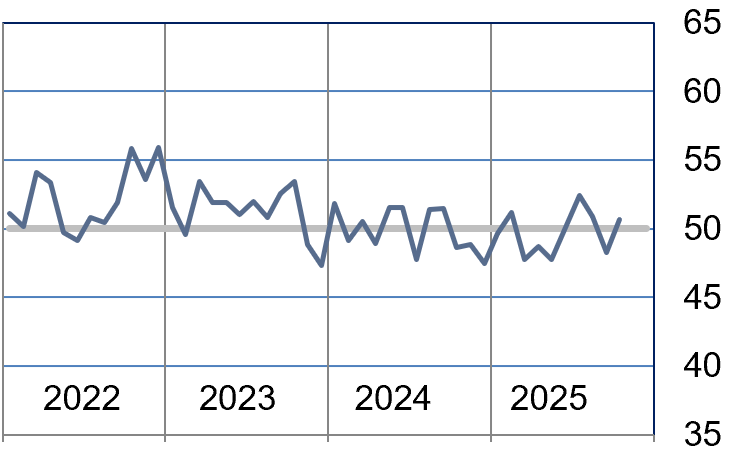
Finished Goods Inventory Index (Not Seasonally Adjusted)
The manufacturing sector shifted from contraction to expansion The nonmanufacturing sector remained in expansion with a slight increase in its rate of expansion.
| Higher | Same | Lower | Net | Index | |
| May/25 | 2% | 92% | 6% | -4% | 48.0 |
| Jun/25 | 9% | 88% | 3% | 6% | 53.1 |
| Jul/25 | 8% | 90% | 2% | 6% | 53.1 |
| Aug/25 | 5% | 91% | 4% | 1% | 50.4 |
| Sep/25 | 8% | 85% | 7% | 1% | 50.3 |
| Oct/25 | 10% | 84% | 6% | 4% | 51.9 |
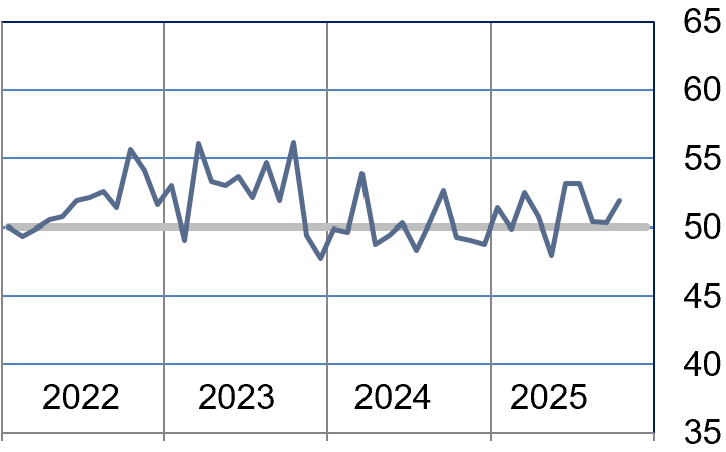
Projections for Key Long-Term Indicators
In addition to the current status of business activities, respondents to the ISM-Houston Business Survey also provide feedback on their view of the direction of the sales/new orders and employment indices six months into the future.
Six-Month Projection of the Sales/New Orders Index
The manufacturing sector and nonmanufacturing sector are both indicating contraction but at slower rates than September.
| Higher | Same | Lower | Net | Index | |
| May/25 | 16% | 76% | 8% | 8% | 43.4 |
| Jun/25 | 14% | 75% | 11% | 3% | 41.9 |
| Jul/25 | 13% | 82% | 5% | 8% | 51.2 |
| Aug/25 | 7% | 87% | 6% | 1% | 49.2 |
| Sep/25 | 16% | 77% | 9% | 5% | 51.9 |
| Oct/25 | 15% | 78% | 7% | 8% | 49.4 |

Six Month Projection of Employment Index
The manufacturing sector is indicating contraction at a faster rate for October. The nonmanufacturing sector remains in expansion with a slight increase in its rate vs September.
| Higher | Same | Lower | Net | Index | |
| May/25 | 12% | 75% | 13% | -1% | 49.1 |
| Jun/25 | 13% | 77% | 10% | 3% | 51.7 |
| Jul/25 | 10% | 83% | 7% | 3% | 52.5 |
| Aug/25 | 18% | 69% | 13% | 5% | 53.5 |
| Sep/25 | 14% | 77% | 9% | 5% | 51.9 |
| Oct/25 | 13% | 79% | 8% | 5% | 54.6 |
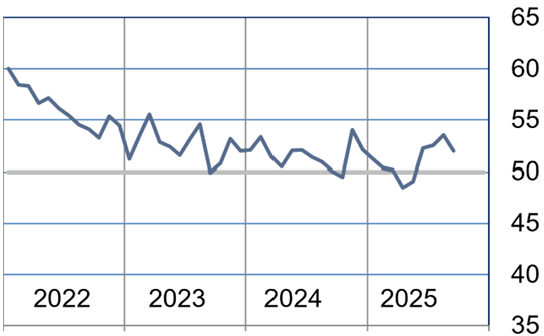
Background on the ISM-Houston Business Report and HPMI Calculation Methods
The Houston Purchasing Managers Index has been included as an integral part of the ISM-Houston Business Report since the Houston chapter of the Institute for Supply Management started publication of this document in January 1995. The report and index are published monthly as the primary deliverables from a survey of Houston area Supply Chain leaders regarding the status of key activities believed to provide insight into the strength of the economy. The respondents come from diverse organizations including construction, energy, engineering, health care, durable and non-durable goods manufacturing, financial and business services, wholesale and retail trade, and utilities related companies.
The Houston Purchasing Managers Index is determined from diffusion indices of the eight indicators of economic activity covered by the ISM-Houston Business Survey and Report. These underlying indicators are sales or new orders, production, employment, purchases, prices paid for major purchases, lead times from sellers, purchased materials inventory (raw materials and supplies), and finished goods inventories. The respondents to the survey report the direction of each these activities as either up, the same or down in comparison to the previous month. An index for each of these areas is then calculated by subtracting the percentage of respondents that sight a negative shift from the percentage that sight a positive shift. For indicators that are positively correlated with economic growth, this results in an underlying index that points to expansion when it is above zero. Indicators that are negatively correlated with growth point to expansion when they are below zero.
The final Houston PMI is calculated by applying optimal regression factors to each of the eight underlying indicators noted above. These regression factors are determined using standard regression techniques comparing these underlying indicators to the Houston-The Woodlands-Sugar Land Business Cycle Index (Houston BCI), which is reported on a monthly basis by the Federal Reserve Bank of Dallas. This top-level index is converted to a 0 to 100 scale to match that of the national Purchasing Managers Index® (PMI®) which is published monthly by the Institute for Supply Management® (ISM®). Readings over 50 for the HPMI generally indicate manufacturing expansion in the Houston in the near term and readings below 50 show coming manufacturing contraction.
It is important to note that the manufacturing breakeven HPMI does not equate to the breakeven point for the overall Houston economy. ISM-Houston periodically reviews the capability of its correlations and adjusts the regression factors when appropriate. The most recent revision occurred as a result of a review undertaken during the third quarter of 2018, which determined that changes in the Houston economy over the last decade have shifted the intercept of the correlation, causing a neutral Houston PMI to no longer align with a neutral Houston BCI. A Houston PMI of 45 points now equates to a neutral Houston economy as measured by the Houston BCI. A similar offset between the National PMI and the National economy has existed for some time.
Use of ISM-Houston Business Report Content
All information contained in this report is protected by copyright laws and ISM-Houston retains all rights to this Content. ISM-Houston hereby grants you a limited, revocable license to access, print, and display this Content solely for your personal, non-commercial use. Requests for permission to reproduce or redistribute ISM-Houston Business Report Content can be made by contacting the ISM-Houston Business Survey Committee at hpmi@ism-houston.org.
ISM-Houston shall not have any liability, duty, or obligation for or relating to the ISM-Houston Business Report Content or other information contained herein, any errors, inaccuracies, omissions or delays in providing any ISM-Houston Business Report Content, or for any actions taken in reliance thereon. In no event shall ISM-Houston be liable for any special, incidental, or consequential damages, arising out of the use of the ISM-Houston Business Report.